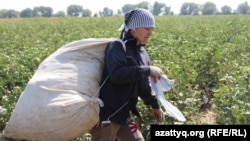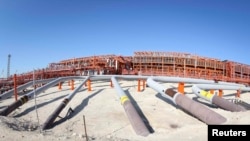
Uzbekistan just had its annual cotton fair. During the October 12-13 event in the Uzbek capital, Tashkent, Uzbekistan reported that it had signed contracts to sell some 550,000 tons of cotton and finished textiles for some $1.32 billion. Something is going right because last year Uzbekistan reported sales of 700,000 tons of cotton and finished textiles for just over $800 million.
No matter what the sales figures say, the cotton business in Uzbekistan rides on the back of slave labor. Uzbekistan’s cotton harvest is possible because, every year, hundreds of thousands of the country’s citizens are forced into the fields. Also every year, the harvest claims the lives of a dozen or more people.
On this week's Majlis podcast, we look at the cotton harvest, not only in Uzbekistan but in other Central Asian countries.
Moderating the discussion was RFE/RL Media Relations Manager Muhammad Tahir. From Germany, Umida Niyazova, longtime Uzbek activist, independent journalist, and founder of the Uzbek-German Forum for Human Rights, joined the talk. From the International Labor Rights Forum in Washington, D.C., Kirill Boychenko, who is the coordinator of the Cotton Campaign, a coalition dedicated to stopping use of forced labor in Central Asia, took part. Steve Swerdlow, the Central Asia researcher for Human Rights Watch, participated. I pitched in on the discussion also, of course.
Niyazova started the discussion, giving an idea of who is being sent to the fields.
“Among them there are students, heads of organizations, representatives of various professional spheres, and we can say that the majority of state organizations’ employees,” she said. She added that another group sent to the fields are “those who are receiving different social benefits, mostly women and small children.”
How many people? “We estimate -- it’s our very lowest [estimate] -- around 1 million people are forced to go out to pick cotton every year,” she said.
Swerdlow called it “a mass mobilization of the entire population in almost a war-effort manner.”
For those in the fields, the hours are long. For some people, most, even all, of the daylight hours are spent picking cotton. When the harvest starts in early September, the temperatures in some places climb well over 40 degrees. There are quotas to be met and those who fail to pick the assigned weight are often abused -- verbally, even physically -- by local officials tasked with gathering the cotton.
And that has included the man who is currently Uzbekistan’s acting president, Shavkat Mirziyaev.
“Mirziyaev himself did this. We have a report that in the year 2000, when he was [Jizzakh] regional governor, he beat up a math teacher because the students of that math teacher were apparently picking cotton too slowly,” Swerdlow recalled.
It is not only those in the fields who are affected. As Swerdlow reminded us, “We had a mother lose her baby just a few days ago because the doctors were not in the clinic where she went to give birth.”
Niyazova added, “We saw schools where 80 percent of the teachers were out in the fields and in the whole school there were only a few teachers who stayed with the kids.”
Boychenko said the situation in Turkmenistan is comparable.
“We also see mass mobilization of public sector employees. Again, independent monitors are reporting about children being sent into the fields,” Boychenko explained.
Of course, there are options.
“You can buy freedom from picking cotton. It costs around $100 for 20 days,” Niyazova said. Boychenko said the same about Turkmenistan. “If you want to be free [from picking cotton], you need to buy your freedom,” he said.
It is worth noting that “farmers are also obliged to grow cotton,” Niyazova said, adding that “for most of the farmers to grow cotton is not profitable” since “the government sets up the procurement prices for cotton and farmers are obliged to sell cotton only to the government.”
The Majlis guests are all involved in fighting forced labor in Uzbekistan's cotton campaign. But it is a difficult task.
“Systematic forced labor in the cotton sector remained from the Soviet time,” Niyazova said.
So, too, has the patriotic calls to citizens. Uzbekistan’s authorities say picking cotton is serving the nation, that cotton is the country's "white gold.”
There have been some successes in efforts to combat the use of forced labor in cotton harvesting in Uzbekistan.
The Cotton Campaign persuaded many Western companies to boycott Uzbek cotton until the use of forced labor in the fields is halted. Such pressure convinced the Uzbek authorities to allow international monitors to enter the country at harvest time, though they are limited in the areas they can visit.
Such pressure also led to a significant reduction in the use of child labor in Uzbekistan’s cotton fields. Instead, their places are often taken by the children’s teachers, doctors, and parents.
Swerdlow recalled, “The European Parliament took a very important step in 2011 when they refused to reduce the tariffs on the import of [Uzbek] cotton into Europe.”
Boychenko said, “If the Uzbek government understands that [sanctions for using forced labor] can influence their profits, they are prone to change.”
Efforts by Western countries and organizations have had some effect on Uzbekistan’s policies toward labor in the cotton fields. But a list of purchasers for Uzbekistan’s cotton shows it is mainly companies from non-Western countries that buy the cotton.
At the 2015 cotton fair in Tashkent, for example, the majority of sales were made to buyers from Bangladesh, China, Turkey, Singapore, Malaysia, Indonesia, Vietnam, Poland, the U.A.E., Czech Republic, Great Britain, Iran, and Russia.
Niyazova summed up the situation, saying, “There are no other countries where forced labor is a state policy and that means that forced labor will stop in Uzbekistan when Uzbek authorities stop forcing people to go to the fields.”
The Majlis went deeper into these topics and other issues surrounding the use of force labor in the cotton fields of Central Asia.
Listen to or download the Majlis podcast above or subscribe to Majlis on iTunes.
The views expressed in this podcast do not necessarily reflect the views of RFE/RL.








